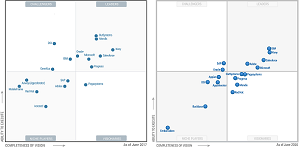News
Mobile Dev Platforms Boost Enterprise App Inventories, Analyst Says
- By David Ramel
- June 15, 2017
Facing an ever-increasing demand for more mobile apps, enterprises that use mobile development platforms are shipping more apps than average, according to a new research report.
That finding came from Gartner Inc.'s latest "Magic Quadrant for Mobile App Development Platforms" report, just published this week.
Citing previous research, the new report noted that enterprises still haven't deployed that many apps -- an average of eight -- but organizations using MADPs typically have deployed a lot more apps than average respondents to prior surveys.
"Additionally, the number of apps in development and planned for the next 12 months were also higher for the MADP users than the average," the report says. "Although the sample size is small, the survey results corroborate Gartner's empirical and anecdotal evidence that organizations using MADP tend to have a higher volume of mobile apps."
As far as the vendors supplying MADPs, Gartner placed three companies in the "Leaders" section of its quadrant that also made the list in last year's report: Kony, Salesforce and Microsoft. Companies joining that list this year are Oracle, OutSystems, Mendix and Progress, while Adobe and IBM fell into other quadrants.
OutSystems was atop the "Ability to Execute" axis of the quadrant, while Kony topped the "Completeness of Vision" quadrant. As always, Gartner cautioned against using the quadrant as a simplistic tool for choosing a vendor, saying such a task should be undertaken with stakeholders and in consideration of specific use cases, skill sets, resources and other factors.
 [Click on image for larger view.]
2017 and 2016 Magic Quadrants for MADPs (source: Gartner and OutSystems)
[Click on image for larger view.]
2017 and 2016 Magic Quadrants for MADPs (source: Gartner and OutSystems)
In its research, Gartner contrasts MADPs with other coding products, such as low-level, manual coding tools like React Native, high-productivity, rapid mobile app development (RMAD) offerings specifically designed to create mobile apps with little or no coding, and mobile back-end services. Gartner says MADPs are different from those tools, providing this partial definition: "A MADP provides tools, technologies, components and services that together constitute the critical elements of a platform for creating custom mobile apps (that is, .ipa and .apk binary files), as well as mobile Web apps or sites."
The platforms must also provide cross-platform tooling, meet diverse use cases and centralize dev activities such as design, develop, test, distribute, manage and analyze, among other criteria.
In comparing 2015 and 2016 mobile dev research surveys (not Magic Quadrant reports), Gartner noted a decrease in the percentage of respondents reporting they haven't undertaken any mobile app development (from 39 percent in 2015 to 27 percent in 2016). With almost three out of four organizations having done some kind of mobile app development in a 2016 survey, Gartner said the practice has finally been mainstreamed, but companies still haven't responded quickly to the demand for apps.
"Many IT teams will have significant backlogs of application work that need completing, which increases the risk of lines of business going around IT to get what they want sooner," said analyst Adrian Leow in a statement about low enterprise app development spending. "Development teams need to rethink their priorities and span of control over mobile app development or risk further erosion of IT budgets and the perceived value of IT development."
Gartner also had some advice for such enterprises in this week's report.
"If you don't already use a MADP, evaluate and deploy one as a cornerstone product supporting your mobile development strategy, especially if your organization is starting to develop and deploy mobile apps at high volume (for example, more than six apps per year)," the company said. "A MADP will provide uniformity across app projects and enable a more scalable infrastructure for [mobile back-end services] (MBS), including addressing the emergence of chatbots, [virtual personal assistants] (VPAs) and conversational UI channels."
Other advice included:
- If you already use a MADP (either one listed in this Magic Quadrant or not) and are thinking of switching providers, consider whether it may be better to supplement the missing functionality by adding RMAD tools or MBS offerings.
- If you use a MADP that no longer meets your needs or that you feel may not be viable, start evaluating other platforms -- not just on current needs but also on your future app requirements 12 to 18 months out, which may include wearable technologies and post-app digital endpoints.
- If you use a MADP and are happy with it, you still need to assess its capabilities and roadmap features at least every six to 12 months to make sure that it continues to align with your organization's expectations and plans.
"Gartner expects the MADP space to continue to evolve rapidly: as wearables, bots and conversational UI channels need to be folded into the omnichannel approach of these platforms; and as mobility permeates deeper in other enterprise systems and platforms," the report concluded.
About the Author
David Ramel is an editor and writer at Converge 360.